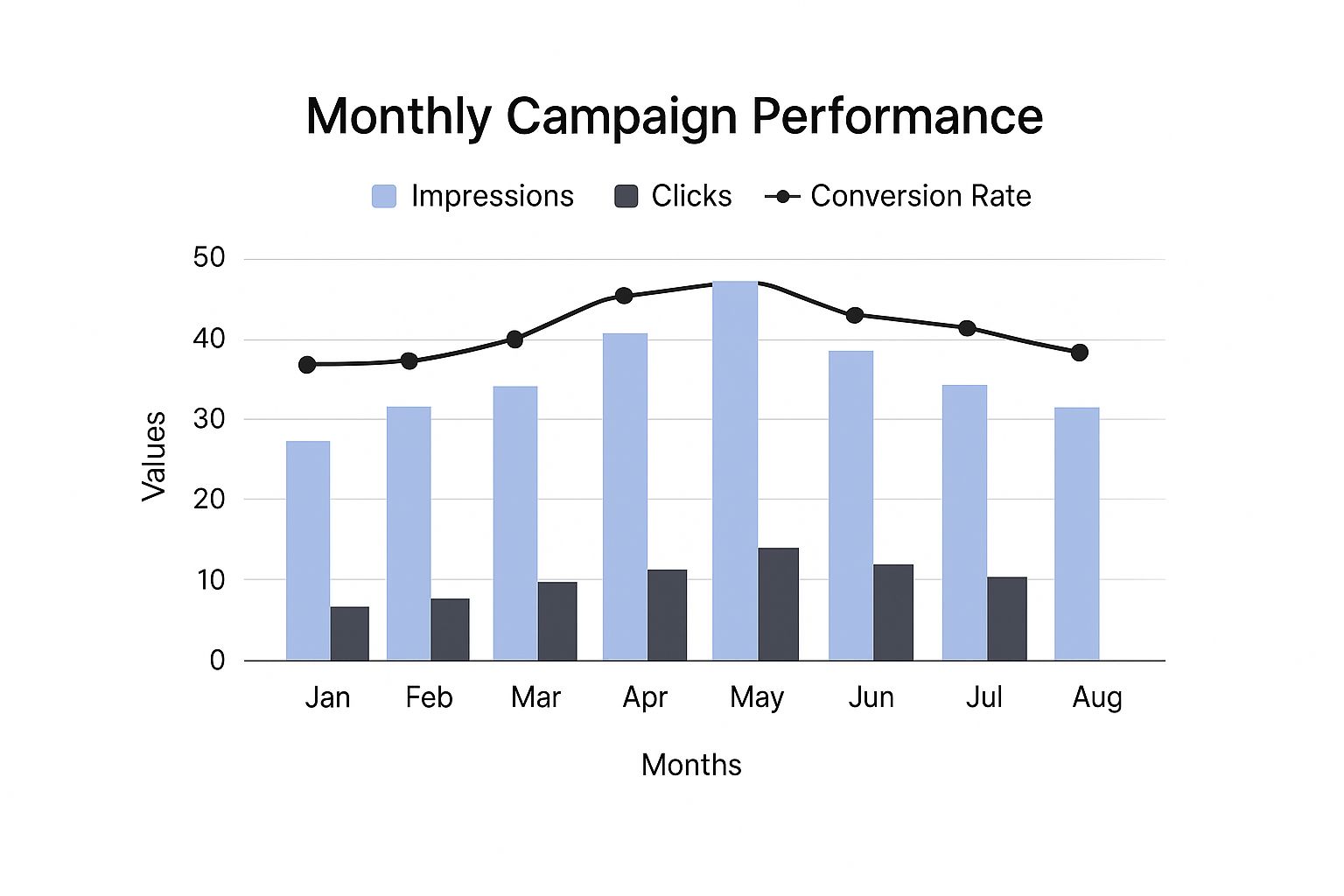How to Measure Marketing Effectiveness: Top Strategies
How to Measure Marketing Effectiveness: Top Strategies
Beyond Vanity Metrics: The New Marketing Measurement

Measuring marketing effectiveness is no longer about tracking superficial engagement. Instead, the focus has shifted to business outcomes. This means we need a new way of thinking about measurement, going deeper than likes and shares to understand the entire customer journey. Connecting marketing activities to tangible results like leads, conversions, and revenue is key.
From Last-Click to Multi-Touch Attribution
Traditional attribution models, especially those using a last-click framework, don't capture the nuances of how customers interact with brands today. Customers rarely convert after just one interaction. Their journey involves multiple touchpoints across various channels over a longer period. To accurately measure marketing campaign success, consider how you measure marketing campaign success.
Multi-touch attribution is crucial. This model gives credit to every touchpoint in the customer journey, providing a more accurate view of what's really driving results.
For example, a customer might discover your brand on social media, visit your website via a display ad, and finally convert after receiving an email offer. Multi-touch attribution would give credit to each of these interactions, revealing the contribution of social media, display advertising, and email marketing to the final conversion.
Breaking Down Silos for Integrated Measurement
Traditional marketing measurement often happens in silos, with each channel tracked separately. This fragmented view hides how the customer journey works and prevents marketers from seeing the whole picture. Integrating measurement across all channels and touchpoints is key to understanding how different activities interact and contribute to overall business goals. This requires a unified perspective on marketing performance, connecting data from various sources to tell a cohesive story of customer behavior.
Social media also plays a vital role in measuring effectiveness. For example, 66% of social media marketers find humorous content most effective, followed by relatable (63%) and trendy (59%) content. You can find more detailed statistics on HubSpot. This highlights the importance of platform-specific data.
The Future of Marketing Measurement
The future of marketing measurement hinges on data-driven decisions, powered by advanced analytics and a laser focus on business outcomes. This requires a shift in perspective, from seeing measurement as a reporting task to a strategic driver of growth.
By adopting integrated measurement and focusing on the metrics that truly matter, businesses can unlock the full potential of their marketing efforts. This empowers marketers to optimize campaigns, personalize customer experiences, and maximize ROI. As technology evolves, we can expect more sophisticated measurement tools and techniques, further improving our ability to understand and optimize marketing performance.
The Metrics That Actually Drive Marketing Growth
Not all metrics offer the same value. Some provide real insights into how your campaigns are performing and how customers behave. Others, like vanity metrics such as follower count or page views, can be misleading. To understand which metrics truly drive growth, it's essential to know how to effectively measure marketing ROI. This means focusing on indicators directly linked to business results.
Key Metrics for Measuring Marketing Effectiveness
Successful marketing teams understand they need to look beyond vanity metrics. They focus on metrics that predict future success and help with strategic decisions.
- Customer Acquisition Cost (CAC): CAC is the total cost of acquiring a new customer. Lowering your CAC is key for sustainable growth.
- Lifetime Value (LTV): LTV predicts the total revenue expected from a single customer throughout their relationship with your business. A higher LTV suggests stronger customer loyalty and higher profitability.
- Attribution-Adjusted ROI: This metric accurately measures return on investment by looking at every touchpoint in the customer journey. It gives a clearer picture of which marketing activities are most effective.
Matching Metrics to Business Models
Different business models need different measurement strategies. For instance, a business-to-business (B2B) company typically has a longer sales cycle and focuses on lead nurturing. This requires a different approach than a direct-to-consumer (D2C) brand, which might prioritize immediate conversions. You may find this helpful: How to master your marketing channel performance. This tailored approach ensures that the metrics align with the specific aims and obstacles of each business type.
Setting Useful Benchmarks
To properly measure marketing effectiveness, you need relevant benchmarks. These should be based on your industry, company's growth stage, and competitors. A startup in a fast-growing market, for example, might have a higher target CAC than an established company in a mature industry. Also, regularly reviewing campaign performance data can help adjust these benchmarks over time.
The following table provides an overview of essential metrics categorized by marketing channel. It explains what success looks like for each channel and offers a way to measure true effectiveness.
Essential Marketing Effectiveness Metrics by Channel
| Marketing Channel | Primary Metrics | Secondary Metrics | What Success Looks Like |
|---|---|---|---|
| Social Media | Engagement Rate, Reach, Click-Through Rate | Follower Growth, Impressions | High engagement, targeted reach, website traffic |
| Email Marketing | Open Rate, Click-Through Rate, Conversion Rate | Unsubscribe Rate, Bounce Rate | High open and click-through rates, conversions aligned with campaign goals |
| Paid Advertising | Cost Per Click (CPC), Conversion Rate, Return on Ad Spend (ROAS) | Click-Through Rate, Impression Share | Low CPC, high conversion rate, strong ROAS |
| Search Engine Optimization (SEO) | Organic Traffic, Keyword Rankings, Conversion Rate | Bounce Rate, Time on Site | Increased organic traffic, improved keyword rankings, conversions from organic search |
| Content Marketing | Website Traffic, Lead Generation, Social Shares | Time on Page, Scroll Depth | High website traffic from content, qualified leads generated, content shared widely |
This table highlights how different channels require different metrics for success. While conversion rate is a common thread, each channel has unique primary metrics that reflect its specific purpose.
Analyzing Campaign Performance Data
The infographic below compares monthly campaign impressions and clicks with the conversion rate trend.

The visualization shows that impressions and clicks generally increase over time. However, the conversion rate fluctuates. This tells us that optimizing for conversions requires more than just increasing visibility and engagement. Things like targeting and landing page experience also play a key role in making those clicks count. By analyzing this kind of data, marketers can pinpoint areas for improvement and allocate resources more strategically. This data-driven approach is essential for achieving sustainable marketing growth.
Decoding Social ROI: Beyond Likes and Shares

Social media is more than just racking up likes and shares. To truly measure its effectiveness, we need to understand how social media activities connect to tangible business outcomes. This means looking beyond vanity metrics and focusing on the real impact on your bottom line. Leading brands are already doing this, connecting their social media activities to concrete business results. They understand that true social ROI is about more than surface-level engagement.
Measuring True Social ROI
Successful marketing teams are moving beyond simple metrics like follower count. Instead, they measure the true return on investment (ROI) of their social media efforts. They achieve this by using advanced attribution models that capture social media's influence across the entire customer journey. It’s not about the last click; it’s about understanding how social media contributes at each stage. For example, social media could play a key role in building initial brand awareness, even if the final conversion occurs elsewhere.
Furthermore, measuring brand equity development, community value, and the impact on customer service requires going beyond traditional analytics. These areas, while harder to quantify than website clicks, are essential for long-term success. They contribute significantly to brand perception and customer loyalty, which in turn impacts long-term growth.
Let's take a look at the effectiveness of various social media content formats in driving business outcomes.
To help illustrate this point, the following table provides a comparison of different content types and their effectiveness across several platforms.
Social Media Content Performance Comparison: Comparison of effectiveness rates for different content types on social media platforms based on industry research.
| Content Type | Effectiveness Rate | Best Platform | Key Performance Indicators |
|---|---|---|---|
| Video | High | YouTube, Facebook, Instagram, TikTok | Views, Watch Time, Shares, Comments, Conversions |
| Images | Medium | Instagram, Pinterest, Facebook | Likes, Shares, Comments, Saves, Click-throughs |
| Blog Posts/Articles | Medium | LinkedIn, Twitter, Facebook | Shares, Comments, Click-throughs, Website Traffic |
| Infographics | Medium | LinkedIn, Pinterest, Twitter | Shares, Saves, Click-throughs, Website Traffic |
| Short-form text updates | Low | Twitter, Facebook, LinkedIn | Likes, Comments, Retweets, Shares |
This table highlights the importance of selecting the right content format for your chosen platform. As you can see, video content tends to perform well across various platforms, while other formats excel on specific channels. Choosing the appropriate content and platform for your target audience is crucial for achieving desired results.
Practical Approaches for Social Media Measurement
Practical approaches for measuring social ROI often involve combining social listening tools with sales data. This provides a more comprehensive picture of how social media impacts your business. Social listening offers valuable insights into brand perception and customer sentiment, while sales data tracks actual conversions. This combined approach helps create robust measurement frameworks that capture the full impact of social media initiatives.
For instance, tracking brand mentions alongside sales figures can reveal correlations between social media activity and revenue. This analysis can help determine which social media campaigns are most effective at driving sales. This data-driven approach ensures you invest in the right social media strategies. Furthermore, understanding how social media affects your customer service can significantly improve the overall customer experience.
Advanced Attribution Models for Social Media
Implementing advanced attribution models is vital for measuring social ROI. These models give credit to social media touchpoints across the customer journey, not just at the point of conversion. This provides a more accurate understanding of how social media contributes to business outcomes. This approach is especially important for measuring the effectiveness of influencer marketing. Influencer activity often focuses on building awareness and driving engagement across different social media channels. Learn more about selecting digital marketing attribution models. For example, even if an influencer doesn't directly generate sales, their impact on brand awareness might be significant and should be considered during measurement.
By adopting this comprehensive approach to measurement, brands can deeply understand how their social media initiatives truly affect their business. This understanding helps allocate resources efficiently and optimize social strategies for maximum impact.
Influencer Marketing Measurement: Beyond Reach and Engagement
Influencer marketing has changed how brands connect with their audiences. But to really understand its impact, we need to look past simple metrics like reach and engagement. Likes and follower counts don't tell the whole story. Smart brands are using more advanced methods to measure influencer campaign effectiveness, focusing on multi-layered frameworks.
Establishing Meaningful KPIs
Effective measurement starts with defining Key Performance Indicators (KPIs) that match your goals. Engagement metrics are helpful, but they shouldn't be your only focus. Think about KPIs tied directly to your desired outcomes.
For example, if you're aiming to boost brand awareness, track website traffic from influencer campaigns or changes in branded search volume. If your goal is sales, measure conversions from influencer-promoted links.
Implementing Proper Attribution Models
To truly understand influencer impact, you need the right attribution models. These models show how much each touchpoint, including influencer interactions, contributes to a conversion. This goes beyond the last-click attribution model, which only credits the final step before a purchase.
Multi-touch attribution gives a more complete view of how influencer marketing works with other marketing activities. You can learn more here: How to master digital marketing attribution models. This is key for showing the real value of influencer marketing and improving future campaigns.
Influencer marketing is now essential for digital strategies, letting brands connect authentically with their audiences. The global influencer marketing market is expected to reach $33 billion by 2025. In the U.S. alone, spending topped $8.14 billion in 2024, a 16% year-over-year jump. More stats can be found here: DesignRush Marketing Statistics.
Quantitative and Qualitative Assessments
The best measurement combines quantitative data (like conversion rates and website traffic) with qualitative data (like brand sentiment and audience feedback). Quantitative data shows campaign performance, while qualitative data adds context.
Looking at social media comments, for instance, can reveal how an audience feels about your brand after an influencer campaign. This combined view gives a much richer understanding of campaign performance.
Comparing Influencer ROI Against Other Channels
Finally, compare the return on investment (ROI) of influencer marketing with other channels. This analysis reveals how influencer marketing performs compared to other strategies. By looking at ROI across channels, you can make better decisions about your budget and get the best results across all your marketing efforts. This comparison helps you figure out the right place for influencer marketing in your overall strategy.
Leveraging Technology To Transform Marketing Measurement

The technology available for measuring marketing effectiveness is constantly changing. This creates both exciting opportunities and new challenges for marketers. Many organizations are adopting advanced tools to improve how they measure their marketing efforts. Some of these tools include AI-powered attribution models, predictive analytics platforms, and customer data platforms (CDPs). These technologies offer powerful solutions to ongoing measurement problems. They go beyond basic metrics to provide a more detailed understanding of marketing performance.
Solving Measurement Challenges With Technology
These advanced technologies help address challenges that have troubled marketers for years. For instance, cross-device tracking has become increasingly difficult. Consumers switch between their phones, tablets, and computers throughout the day. New technologies help connect these customer journeys across multiple devices. This gives marketers a more accurate picture of individual customer behavior.
Another hurdle has been online-to-offline attribution. It's tough to accurately attribute conversions that involve both online and offline touchpoints. Modern solutions offer ways to connect these online and offline interactions. This allows businesses to measure the complete customer journey.
Incrementality testing also helps determine the true impact of marketing efforts. It isolates the effects of marketing activities from other factors. This process involves comparing two groups: one exposed to a specific marketing activity (the test group) and one that isn't (the control group). The difference in outcomes reveals the incremental lift created by the marketing activity. This provides valuable insights for optimizing future campaigns. You might be interested in: Best marketing attribution tools to boost your strategy.
The Power of Machine Learning In Marketing Measurement
Successful marketing teams are using machine learning to find hidden patterns and insights within their data. Algorithms can identify trends that human analysts might miss. They reveal correlations and causations that drive marketing performance. This helps marketers understand which activities contribute to desired outcomes and which need to be adjusted.
For example, machine learning can analyze large amounts of data to predict which customers are most likely to convert or churn. This allows for more targeted and personalized campaigns, increasing efficiency and ROI. Predictive analytics helps anticipate future performance based on historical data and current trends. This allows businesses to make proactive decisions and optimize resource allocation.
Navigating The Privacy Landscape In Marketing Measurement
As concerns about data privacy grow, marketers must adapt their measurement methods. Privacy-preserving techniques like differential privacy and federated learning allow organizations to maintain analytical power while respecting user privacy. These techniques analyze aggregated data without accessing individual user information. This creates a balance between gaining insights and protecting privacy.
Forward-thinking organizations are prioritizing these privacy-focused approaches. They want to ensure their measurement practices align with ethical data handling and build customer trust. By using privacy-centric solutions, marketing teams can continue to gain valuable insights from their data. At the same time, they can safeguard user information and comply with evolving privacy regulations. This approach reinforces ethical practices and strengthens customer relationships. It shows a commitment to data protection.
Building Your Marketing Measurement Ecosystem
Creating a robust framework for measuring marketing effectiveness isn't just about picking the right tools and metrics. It requires a fundamental shift in how your organization works together and a commitment to changing its culture. This section offers a practical roadmap for developing a measurement ecosystem that truly drives business impact. We're talking about going beyond simple reports and making measurement a core driver of strategic decision-making.
Conducting a Marketing Measurement Audit
Start by honestly assessing your current measurement capabilities. This audit should identify both the strengths and weaknesses of your current processes. Where are you doing well in data collection and analysis? Where are the critical gaps that prevent a complete understanding of your marketing performance? For instance, are you effectively tracking conversions across every channel, or are there blind spots in your attribution model? Identifying these gaps helps prioritize areas for improvement, ensuring you focus on the changes that deliver the most immediate value. This is a critical first step toward building a more effective measurement system.
Breaking Down Measurement Silos
Many organizations struggle with measurement silos, where different departments track their own metrics without a shared, unified view. This fragmented approach hides how interconnected the customer journey truly is. Marketing, sales, and customer service teams need to share data and insights to create a cohesive understanding of how marketing influences customer behavior at every touchpoint. This means breaking down those silos and establishing shared KPIs that reflect overall business objectives. For example, aligning marketing metrics with sales data helps demonstrate marketing's direct impact on revenue. This shared understanding is essential for smart, data-driven decisions that benefit the whole organization.
Establishing Clear Governance
Leading organizations establish a governance model for marketing measurement. This model defines roles, responsibilities, and processes for data collection, analysis, and reporting, ensuring consistency and accuracy across the organization. However, this model also needs to be flexible enough to adapt to changing business needs and incorporate new technologies. This means finding a balance between standardization and agility. A well-defined governance model establishes clear ownership of measurement activities while also allowing for continuous improvement and adaptation.
Fostering a Data-Driven Culture
Building an effective measurement ecosystem requires fostering a data-driven culture. This goes beyond investing in new tools and technologies; it means developing data literacy across teams, empowering individuals to interpret and use data in their everyday work. This means providing training and resources that equip team members with the skills they need to understand and apply data insights. Leadership should also actively champion data-driven decision-making, showing how data can inform strategy and improve performance. This creates an environment where measurement is seen as a tool for continuous optimization, not a way to assign blame. By weaving data into the organizational culture, you create a system where everyone uses data to improve their work and contribute to business success. Gaining executive buy-in is also key for securing resources and driving organizational change.
Ready to transform your marketing measurement and gain a clearer understanding of your ROI? LeadPulse helps you connect the dots between your marketing efforts and revenue. See how LeadPulse can help you unlock the full potential of your marketing data. Get started with LeadPulse today!